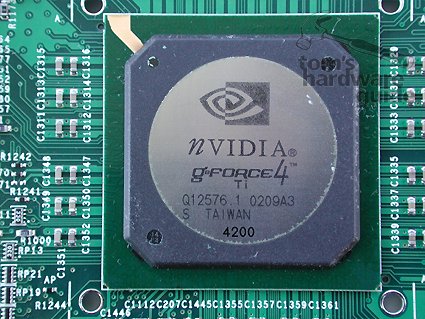NV18 & NV28: NVIDIA Chips with AGP-8x Flavor
Introduction, Continued
| Header Cell - Column 0 | NVIDIAGeForce4 Ti4200 | NVIDIAGeForce4 Ti4200-8x | NVIDIAGeForce4 MX440 | NVIDIAGeForce4 MX440-8x | ATI Radeon 9000 Pro |
|---|---|---|---|---|---|
| Chip Technology | 256-bit | 256-bit | 256-bit | 256-bit | 256-bit |
| Process | 0.15 Micron | 0.15 Micron | 0.15 Micron | 0.15 Micron | 0.15 Micron |
| Transistors | 63 Mio | 63 Mio | - | - | - |
| Memory Bus | 128-bit DDR | 128-bit DDR | 128-bit DDR | 128-bit DDR | 128-bit DDR |
| Memory Bandwidth | 8,2 GB/s | 8,2 GB/s | 8,8 GB/s | 8,8 GB/s | 8,8 GB/s |
| AGP Bus | 1x/2x/4x | 1x/2x/4x/8x | 1x/2x/4x | 1x/2x/4x/8x | 1x/2x/4x/8x |
| Memory | 64/128 MB | 64/128 MB | 64 MB | 64 MB | 64/128 MB |
| GPU Clock | 250 MHz | 250 MHz | 270 MHz | 275 MHz | 275 MHz |
| Memory Clock | (514/500) MHz 64 MB(444) MHz 128 MB | (514) MHzOfficial: 500 MHz | 200 (400) MHz | 256 (512) MHzOfficial: 500 MHz | MHz 275 (550) MHz |
| Speicher | SD/BGA 3,3-4ns | SD/BGA 3,3-4ns | SD 4-5ns | BGA 3,6ns | SD |
| Vertex Shader | 2 | 2 | - | - | 2 |
| Pixel Pipelines | 4 | 4 | 2 | 2 | 4 |
| Texture Units Per Pipe | 2 | 2 | 2 | 2 | 1 |
| Textures per Texture Unit | 4 | 4 | 4 | 4 | 6 |
| Vertex S. Version | 1.1 | 1.1 | - | - | 1.1 |
| Pixel S. Version | 1.3 | 1.3 | - | - | 1.4 |
| DirectX Generation | 8 | 8 | 7.1 | 7.1 | 8.1 |
| FSAA Modi | MultiSampling | MultiSampling | MultiSampling | MultiSampling | SuperSampling |
| Memory Optmizations | LMA II | LMA II | LMA II | LMA II | Hyper Z II |
| Display Outputs | 2 | 2 | 2 | 2 | 2 |
| Chip Internal Ramdacs | 2 x 400 MHz | 2 x 400 MHz | 2 x 400 MHz | 2 x 400 MHz | 2 x 400 MHz |
| Chip External Ramdacs | - | - | - | - | - |
| Bits per Color Channel | 8 | 8 | 8 | 8 | 8 |
| Special | - | - | TV Encoder On-Chip | TV Encoder On-Chip | TV Encoder On-ChipFullStream |
Now we're sure there are some readers out there mournfully looking at their now "outdated" AGP 4x system. But is the twofold increase in speed really necessary, not to mention - tangible? To be blunt: no. Even future applications are unlikely to require a bus interface that is faster than AGP 4x. 8x is more of a future investment than a current requirement.
AGP 8x uses pins that were previously unused. Visually, there is no difference to the 4x connector.
While AGP 4x with its 266 MHz offers a maximum theoretical bandwidth of about 1.1 GB/s, 8x allows for twice as much data to be pushed across the bus, namely 2.1 GB/s. Additionally, there are now several new side-band addressing modes as well as an "isochronous operation" mode, which ensures maximum available bandwidth regardless of system load. This could prove a very valuable addition for video streaming and similar applications. Games, however, aren't nearly as demanding, making this a moot point for gamers.
Get Tom's Hardware's best news and in-depth reviews, straight to your inbox.

